The problem is when the Internet does not work after re Windows installations, can occur not only in Windows 7, but also in Windows 8 and Windows 10. I will later try to prepare a separate article about solving this problem on the “ten”. Besides, I already wrote. Just follow a few tips from the article, and the Internet on your computer will work again.
And in this article, we will look at solutions to the problem when you (or someone else) installed on your computer, or Windows laptop 7, everything worked out and everything works, but there is no Internet connection. There can be a lot of different nuances. Because there are many ways to connect to the internet. Therefore, the solutions will also be different. Looking ahead, I will say that most likely you will just need to install the necessary drivers, or set up an Internet connection (or both). Because, immediately after installation, Windows 7 almost never installs a driver for the Wi-Fi adapter. This means that Wi-Fi will not work after installing Windows 7. Well, if you had an Internet connection configured, then of course you need to configure it again.
It all depends on the connection method, and in some cases on the Internet provider. We will consider the following options:
- Wi-Fi does not work after installing Windows. In almost all cases, simply installing the wireless adapter driver is enough. Windows 10 already installs the driver for Wi-Fi (In most cases), but Windows 7 lags behind in this regard.
- If the Internet does not work via cable from the router. Again, it all depends on the symptom. It may also be that the system was unable to install the driver. network card. You need to check and, if necessary, install it.
- If you previously configured a connection to your provider (high speed), but after reinstalling Windows 7 it is not there. It's quite normal. It is advisable to first check if there are any problems with the network card driver, then simply create a connection to the provider.
- And if you have Internet via a 3G USB modem, then you must install the modem driver, and again, set up a connection to the provider.
Now we will look into everything in more detail and solve problems with connecting to the Internet after installing or reinstalling the operating system.
Why doesn't Wi-Fi work after installing Windows 7?
And so, we installed Windows, we look at the Internet connection icon, but it is not the same as it was before. No available for Wi-Fi connections networks, and we cannot connect to the Internet via Wi-Fi. Most likely, the connection status will be like this (if the network cable is not connected):
The fact is that there is no Wi-Fi at all. No available networks, and most likely you won't even see the wireless adapter. And all because Windows 7 simply could not install the driver on the wireless adapter that is installed in your laptop, and which is responsible for Wi-Fi work. How many times have I reinstalled Windows 7 on different laptops, and the Wireless adapter driver always had to be installed manually.
It's very easy to check. Just go to the device manager and take a look. You can open it different ways. The simplest one: open Start, paste it into the search bar mmc devmgmt.msc, press Enter. Or via "Run". You can also go through “Computer” - “Properties” - “Device Manager”.
In the manager we look for the tab Network adapters . And there should be an adapter with “Wireless” or “Wi-Fi” in its name. Like this:
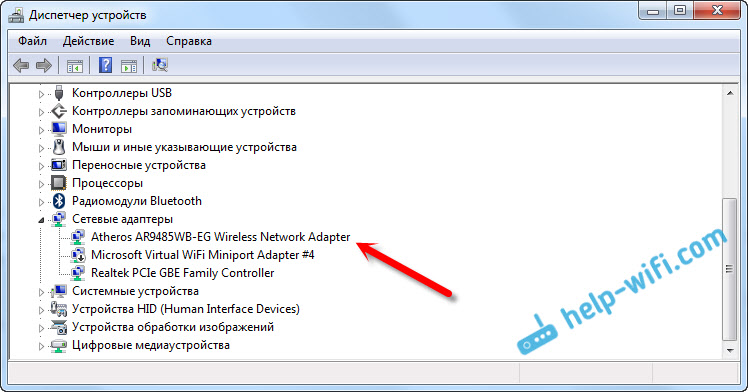
If you do not have such an adapter, or you do have one, but with a yellow one exclamation point and the status “The device is not working correctly”, this means that you just need to install the necessary driver, and everything will work. In this case, there must be at least one “unknown device” in the device manager. This is our Wireless adapter.
The main thing is to install the driver for your laptop model (adapter), and for Windows 7 (in our case). I won't write about this in detail here. Has already detailed instructions About, . After installation, you will be able to networks.
Internet via cable does not work after reinstalling Windows 7
If you have an Internet connection via a network cable from a router, or directly from an Internet provider, but without any settings, when you do not need to create a connection, then first of all we check the network card driver. It also happens that Windows 7 cannot install it either. This is the case when the computer does not respond to cable connection (the icon does not change). And if he sees the connection, but it is “Without access to the Internet,” then look. But this is unlikely.
And so, go to the device manager (how to log in, I wrote above), and on the same “Network adapters” tab we should have a network card. I have this "Realtek PCIe GBE Family Controller". Your name may be different. It all depends on the manufacturer.

If you do not see a network card adapter there, then as is the case with wireless adapter, you need to install the driver. If you have a laptop, then look for the model on the manufacturer’s website and install the driver for the LAN adapter. You can search by the name of the adapter itself. Also, the driver is on the disk that may have come with your computer.
Well, check all the cables, maybe you are connecting something incorrectly.
Lost high-speed connection to ISP on laptop after reinstalling Windows 7
In this case, you just need to create this connection again. Connect the cable from your provider to your computer's network card (it's most likely already connected). If your computer does not respond to the cable, or you are unable to create high speed connection, then check if everything is ok with the network card driver. I wrote about this above.
To create a connection to your provider, click on the Internet connection icon and select "Network and Sharing Center" shared access". Next, click on "Set up a new connection or network."

Select "Connect to the Internet" and click "Next".
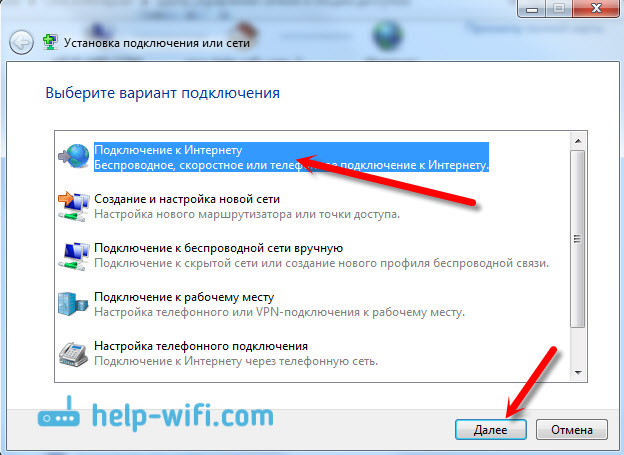
Select "High Speed (with PPPoE)".

Enter the username, password, if desired, check the “Remember this password” checkbox, you can change the name of the connection, and click on the “Connect” button.
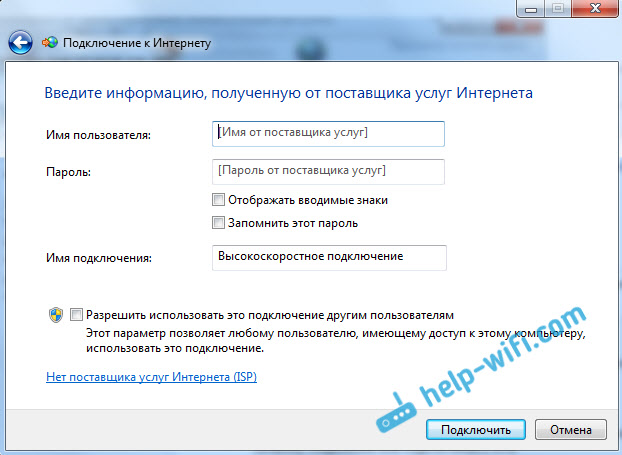
Connection information: username and password, issued by the provider. If you also need to register IP and DNS addresses, you can do this using , in the properties of the adapter "Connect via local network".
Internet does not work via 3G USB modem after installing Windows
As with other connections, you need to install the necessary driver for the modem and configure telephone connection to the operator. It’s difficult to give specific advice here, since everyone has different modems and different operators. You can see the instructions for setting up a connection via a 3G modem.
Installing the 3G/4G modem driver
Everything is simple here. The driver may be on a disk that you may have been given when you connected to the Internet. There are many modems on which the driver is built into the modem itself. To check, connect the modem to your computer and go to "My Computer" (just "Computer" in Windows 7). There may be a drive or disk drive that appears after connecting the modem. We tear it off and start installing the driver. Sometimes, the offer to install software appears immediately after connecting the modem.
If these methods do not work, then look at the modem model and look for a driver on the Internet. Your operator's website should also have the necessary drivers.
Setting up a telephone connection
Once you understand the drivers, you need to create a connection. I don’t know how it is with all the operators (Beeline, Yota, MegaFon, etc.), but with Intertelcom, you need to create a regular telephone connection with a number, username and password.
To create it, go to the "Network and Sharing Center" and select "Set up a new connection or network" (see screenshots above). Next, select “Set up a telephone connection.”
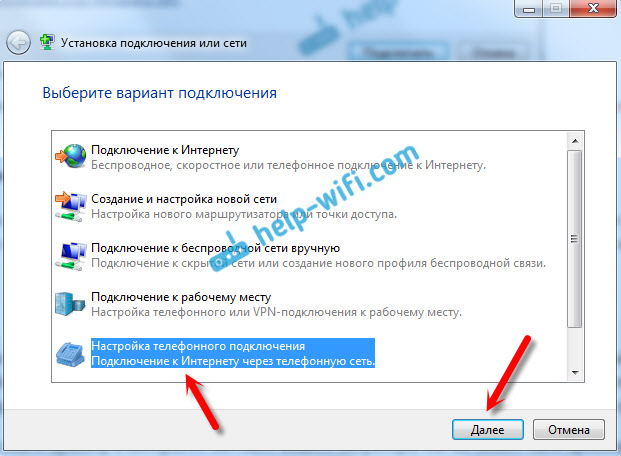
Specify the necessary parameters provided by the provider (number, username, password). The computer will be connected to the Internet and a connection will be created. If an error appears that “Windows cannot detect the modem,” then check the modem driver. Or, to start, just restart your computer.
We bought a brand new laptop or assembled a computer, installed Windows and... What's next? We went to the desktop, and there was only the Recycle Bin. Even if you bought a laptop with already installed Windows, then you still need to configure and install other programs. For what? To improve the performance of your device.
Everyone should have a list of programs that need to be installed immediately after installing the operating system. Here I have prepared my list. The programs below are suitable for any version of Windows (XP, 7, 8 or 10). But first of all, you need to understand the drivers.
For those who have a pirated version! First of all, disable Firewall and Center Windows updates- they are in the control panel. Then activate Windows.
1. Drivers
Drivers (firewood) are programs that are responsible for connecting and proper operation of devices in a computer or laptop. For example: the webcam will not work without specific driver, the monitor will distort the image (stretch, use the wrong resolution), there will be no Wi-Fi, etc.
The first step is to check what is installed and what is not. Many people have pirated versions of Windows, and many people also buy laptops with DOS(without an installed operating system) and then install pirated ones. That and when clean licensed Windows- you still need to install drivers. In all cases, you need to install drivers :) First, check which are installed and which are not, for this: RMB on the shortcut My Computer > Properties > Device Manager.
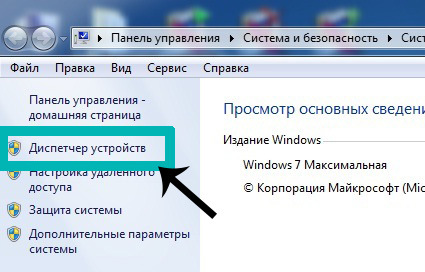
If you have all the drivers installed, you will see something like this.

If a driver is not installed, a yellow exclamation mark will appear next to it.
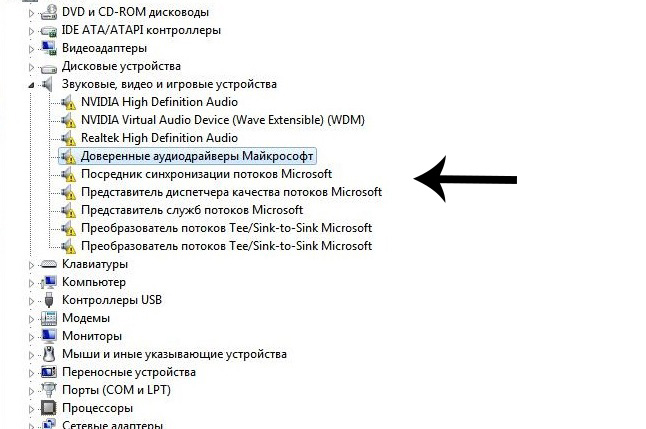
There are three ways to install drivers:
from the manufacturer's official website. For example, if ASUS laptop, then you need to search on the site asus.com;
from the disk that came with the kit (if there was one);
using Driver Pack Solution.
Some drivers may be automatically installed as standard ones, which we do not need. For example, a standard driver may be installed on a video card and then it will not work at full capacity, which will affect the graphics in games or when working in serious photo or video editors.
Most The best way driver installation– download from disk (if it was in the box) or from the official website. Each driver is installed separately. The included disc usually contains drivers for only one version of Windows. The best and optimal solution is to go to the manufacturer’s official website, find the driver in the “Support” menu, select your Windows version and install from there. This way, you will get maximum efficiency and performance from your device. Rule: always download and install drivers from the manufacturer’s official website.

3. Antivirus
To install it, you need to set up an Internet connection or connect to Wi-Fi (fortunately, many people now have it at home). If for some reason there is no Internet, then you need to download the antivirus to a flash drive from a friend and install it from it.
About antiviruses. There are paid and free ones. Leaders among paid ones are antiviruses from Kaspersky, Eset, Dr. Web. Among the free ones - Comodo, Avira, Avast. I have it free Comodo Internet Security, which fully copes with its functions. If you have extra money, buy it paid antivirus for a year. But protection must be mandatory.

4. Browser
Google Chrome, Opera or Mozilla. You download one of them from Microsoft Internet Explorer and set it as your default browser. Personally I install Chrome.

5. Archiver
There are WinRar, WinZip (paid) and 7-zip (free). I always bet 7-zip, reads all formats, there were no problems.

6. Codec
Needed for correct playback of video and audio formats (so you can watch any movie or video in any format). You can download it, it's free. The codec comes with an MPC-HC (Media Player Classic Home Cinema) player. There is, of course, a standard Windows player, but, to be honest, it doesn’t mean anything at all.
10. Flash Player
Flash Player. Responsible for playing animation, video, graphics on the Internet (including YouTube) and for the ability to play online games. If you have Google browser Chrome, you don't need to download this.

11. Daemon Tools
Daemon Tools– emulator program for CD/DVD drives (format .iso). Simulates the presence of a disk in the drive when it is absent. Actively used by gamers for installation pirated versions games. If you intend to play games, you definitely need to download them. + some programs are also installed via emulators.
Responsible for graphics, video and 3D. This is especially true in games. There are different versions.

Additionally
And now a couple more interesting programs for advanced users.
Adobe Photoshop . The most mega super-duper photo editor and more. If you search on the Internet, you can find and install it for free.
![]()
Free Studio. A set of programs for conversion different files(for example, from video format .avi to format .mp4), recording your monitor screen, quickly editing video and audio, downloading videos from YouTube and photos from Instagram. A very useful set.

Picasa. Convenient program for viewing and quickly editing photos. Support has already been discontinued and new versions are not being released, but for those who are used to it and who like this program, I left a link.
(14 ratings, average: 5,00 out of 5)
Today we will talk to you about what to do after reinstalling Windows 7. How to set up the Internet in this operating system? What might we need? How long does it take this process? We will talk about all this today. Let's start by discussing some points about preparing for the process.
Getting ready
Well, if you don’t know what to do after reinstalling Windows 7, how to set up the Internet so that it starts working normally, then let’s understand this difficult issue.
First of all, we need equipment to access the World Wide Web. Now it can be anything - from a USB modem to the most common ADSL modem. Each device has its own configuration method. These are the ones we will look at today.
In addition, if you are thinking about what to do after reinstalling Windows 7, how to set up the Internet so that it works normally, you will have to stock up on time and patience. Quite often, failures and malfunctions can occur in the operating system, interfering with normal operation and slowing down the process of setting up equipment. So let's try to take action with you now.
Preparing the system
You don't know how to connect to the Internet after reinstalling Windows 7? It is worth not only preparing yourself, but also properly preparing the operating system. This will help reduce the risk of failures and malfunctions to a minimum. Especially after a “clean” installation on the computer.
What is needed for this? Install drivers for all connected equipment. Except for the modem, of course. We'll work with him a little later. Instead, take all the driver discs you have, video card, etc.) and install them on your computer one by one. After completing this procedure, do not forget to reboot. 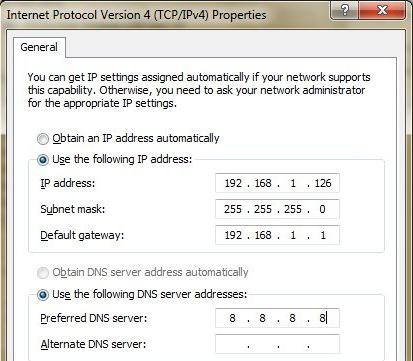
Now we can think about what to do after reinstalling Windows 7. How to set up the Internet? This is quite easy to do if you know where to start. Let's try to deal with more “ancient” equipment, and then we’ll start moving on to innovations.
ADSL modem
So, we begin with you the most common connection to the World Wide Web. In addition, the method currently being considered is considered the oldest. It involves connecting via an ADSL modem.
Don’t know what happens after reinstalling the Internet? We will first have to connect the equipment to the computer. To do this, plug all the wires into the corresponding sockets on the “box”, and one end of the “main” wire should be inserted into the computer. It is connected to a special connector on the network card (it is impossible to mix it up). After this, you can turn on the computer and start working.
We will need to install drivers for the equipment. This is done using installation disk, which, as a rule, comes with the equipment. Ready? Then go to “Control Panel”, and then to “Network and Internet”. There, find “Network and Sharing Center”, and then select “Create a new connection” at the bottom of the window. 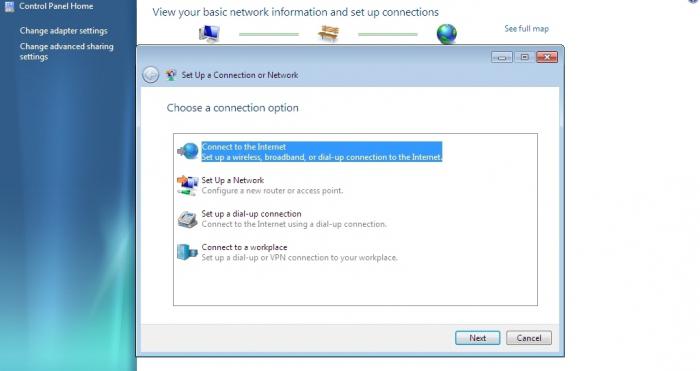
If you do not have Internet after reinstalling Windows 7, then you can continue with our steps. In the window that appears, select “Connect to and then “No, create a connection.” Use “My Internet connection VPN.” Then click on “Delay Internet setup”, enter the IP address in “Internet address”. Name it something connection, create a password and save.
Return to Network and Sharing Center. You will see that a new connection has appeared. Right-click on it and select "Properties". We will work in the "Security" tab. Select “Tunnel Protocol” as the connection type, and “Connect even without encryption” as data encryption.
Are you wondering how to connect to the Internet after reinstalling Windows 7? Go to the "Network" tab. Check the box next to "Internet Protocol Version 6 (TCP/IPv6)" and save. Go to "Connection Properties" again. Now in the “Network” section, click on the properties of “Internet Protocol Version 4” and enter the IP address and in the window that appears (their provider should have told you). Leave the remaining fields blank. Save your changes. That's all.
USB
Are you still wondering what to do after reinstalling Windows 7, how to set up the Internet for normal work on your computer using a USB modem? As a rule, virtually no action is required from you.
You should start by connecting the modem (with a SIM card pre-inserted into it) to your “machine”. It is best to connect the equipment to the slot where it will be more convenient to get it out. After this you will need to install drivers and special program for working with a modem. To do this, you can either use the included disk, or wait a little - installation, as a rule, occurs automatically after connecting the equipment. 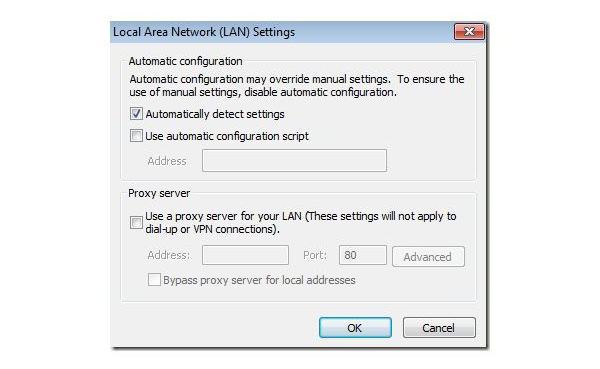
After the process is completed, we will be able to enter the manager program, enter the username and password (phone number and password given to you), and then safely use the Internet connection. As you can see, nothing complicated.
USB router
And here is another rather interesting method that allows you to use the Internet. This is using a USB router. As a rule, there are slightly fewer problems with it than with portable modems.
To begin, insert the SIM card and battery into the equipment. Charge the "machine" using a special charger, and then connect it with a wire to the USB connector. Turn on the equipment and install the necessary drivers on it. They are included with a SIM card and a router.
Now you will need to wait for the installation of a special manager to log into the Network. After the process is completed, you can safely use the Internet. It will be enough to enter your username and password after turning on the router itself. That's it. As you can see, nothing complicated or special.
WiFi
If you notice that you do not have the Internet after reinstalling Windows 7, but have a computer with Wi-Fi equipment connected to the World Wide Web, then do not worry: you can quickly regain access.
![]()
To do this, you will need Wi-Fi on your network card. If this is not possible, then you can buy a special antenna for this undertaking. Install the drivers for the hardware, and then click on the small scale in the tray. There, select your network and click "connect". If necessary, enter the password several times. After some time, you will see how the scale begins to fill, and the computer will display a message indicating a successful connection. You can use the Internet.
On a computer, after each reinstallation of OS Windows 7, you have to reinstall all programs, drivers and connect peripheral devices. But in the age unlimited internet, a person cannot imagine his existence without it. Therefore, the problem of connecting to the global network after reinstalling the operating system always remains relevant.
Connecting to the Internet via routers
Owners of routers (routers) are luckier, since all settings are stored directly on a separate device, so reinstallation is not scary, and you just need to make sure correct setting network between PC and router. On Windows 7, you can check this in the Network and Sharing Center ( Start - Control Panel - Network and Internet - Network and Sharing Center). Next, in the left menu, follow the link “Change adapter settings”
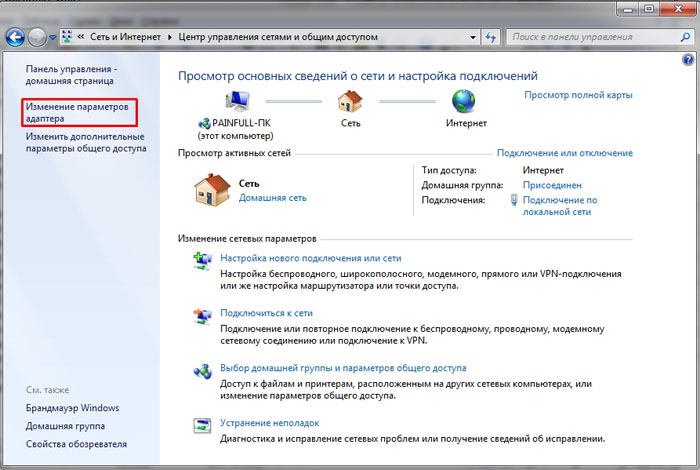
and check that the “local network connection” item is active for the main network adapter:
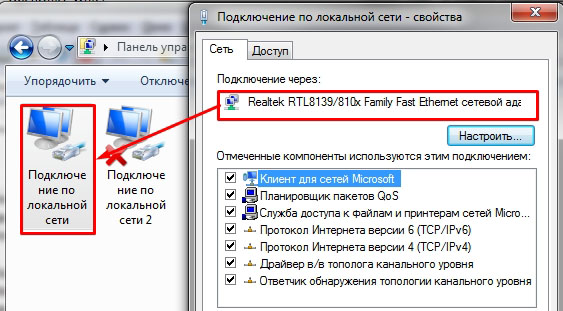
You can check the name of the main network card in Device Manager. The easiest way to find it is to hold down the WIN+Pause key combination (the combination is supported in all versions of the OS, including Windows 8.1).


and in the device tree you need to find the “Network adapters” sub-item. Here a list of all network cards (including virtual ones) installed in the computer will appear.

Another question is when there is not a single network card here, but there are unknown devices - install drivers for your network equipment.
If this does not help, check that you are installing the appropriate software. In the worst case, the network card does not work and needs to be replaced.
When network connection will be established with the router - the Internet connection will be activated automatically.
Direct Internet connection using Windows 7 as an example
If you do not look at the fact that now most providers provide Internet services without using a login and password (binding by MAC address and you just need to insert the cable into the PC), let's take a closer look at how to set up and connect your computer to the Internet using a login and password (PPPoE protocol).
First you need to check how the network card works (checking the network connection). Next, go to: “Start - Control Panel - Network and Sharing Center.”
Here we select the item according to the picture:
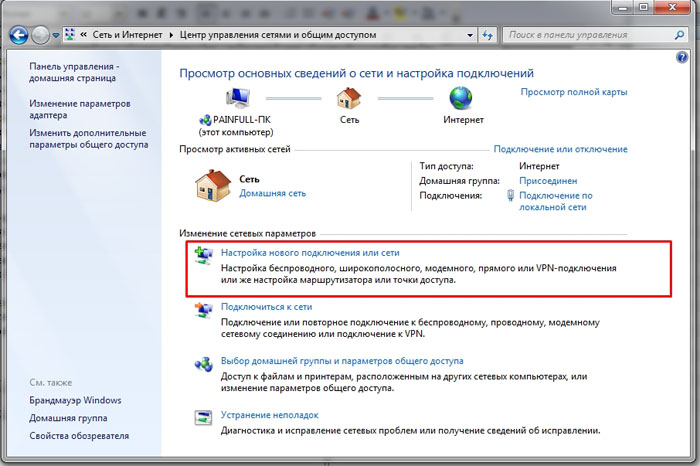
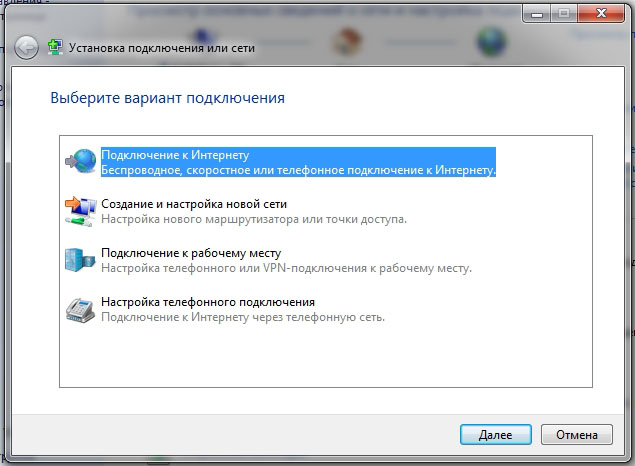
In the next step, select “High-speed (with PPPoE)”:
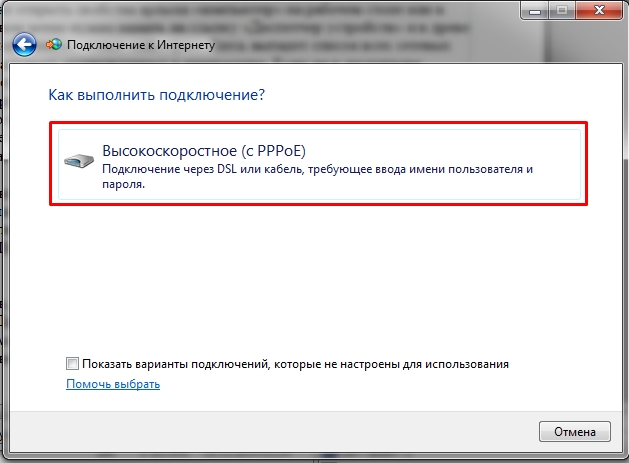
After selecting the connection type, a window will appear with fields that need to be filled in accordingly and click the “Connect” button:
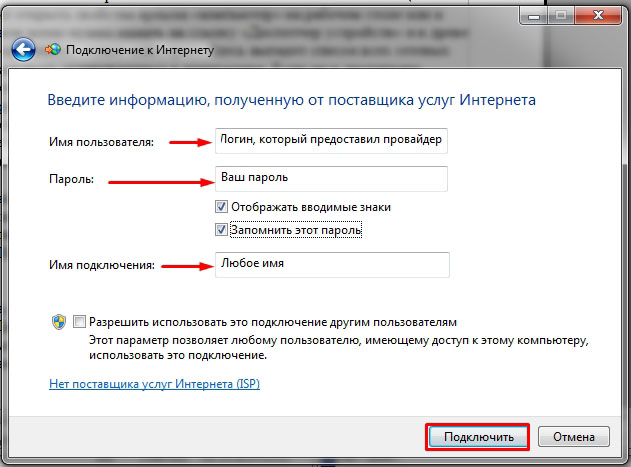
After filling in all the fields, the computer will attempt to connect using the previously entered data:
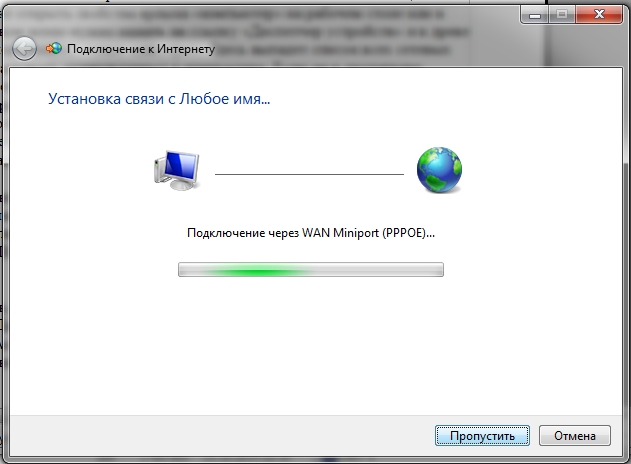
If no mistakes were made at the setup stage, you will be able to connect your Windows 7 computer to the global network right away. If, after all the steps, the Internet does not work, you need to delete the created connection and repeat the process again.
Another way to set up a direct connection on Windows 7
Some providers work using another parameter called “Service Name” to distribute the load between servers. It improves connection stability, but adds hassle to ordinary users.
To configure the service name, you need to go to the properties of the previously created connection. The easiest way is to open the network status indicator, which is located in the system tray, with the left mouse button, find the created connection, open it context menu and go to properties.
Operating room installation Windows systems 7 takes a little time. After reinstalling it on the computer, each user is faced with the need to download all programs, restore settings, connect devices such as a printer, router, etc. But, despite all the connections, a situation often arises when, after Windows installations 7 Internet does not work.
Why does the Internet not work after reinstallation?
This can happen to anyone operating system, but in most cases, after installation, Windows 7 almost never installs the driver on Wi-Fi router, accordingly, because of this it will not work. The reasons may also be due to problems with the equipment or due to the Internet provider.
No driver for adapter
Typically, devices should connect automatically after this, but a driver from the adapter manufacturer will create better conditions for its operation.
The most common reason that the Internet does not work is an incompatible or incorrectly installed driver. And in order to understand whether your computer has this problem, you should:
- Login to the control panel.
- Open network connections.
- Now we check the presence of a local network connection, if there is one, then go to the “Device Manager” and check the activity of the driver for the equipment. If it is not active, then there will be an exclamation mark next to the router icon.
If it is in “Network Connections”, it means the device is not connected, and if it is not in the “Device Manager”, it means that it is not working or the system simply did not detect it.
No settings or connection
Often, in order to access the Internet, a local network is used, and the providers from whom you buy Internet require network card settings. Therefore, you need to see if you have entered the connection settings. To do this you need to go to " Network connections" and highlight local network connections, then click "Details". There we make sure that fields such as IP address, mask, and gateway are filled in. If any line is empty, you need to fill it in manually.
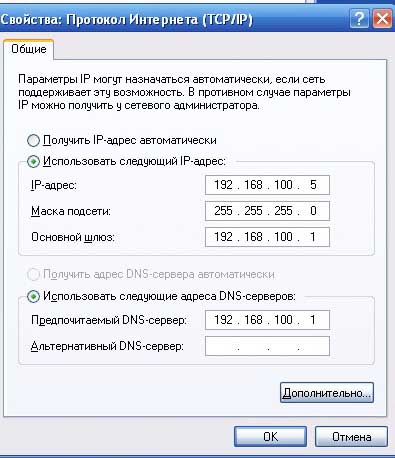
We do it like this:
- go to “Control Panel”, then “Network Connections”;
- left-click to activate “Local Area Connections” and “Properties”;
- Next, find the “TCP/IP” protocol and click on “Properties”;
- enter the provider settings.




